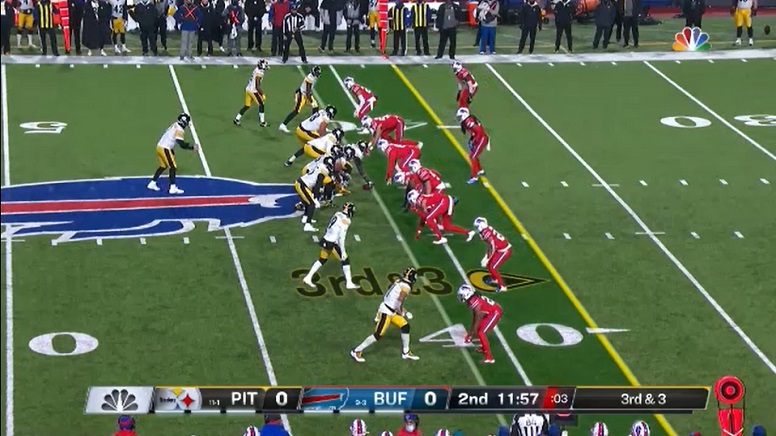The loss on Sunday night to the Buffalo Bills highlighted several glaring weaknesses with the Pittsburgh Steelers. However, I want to take a dive into a specific occurrence from Sunday night– the decision to throw it deep on third-and-short.
With 7:17 left in the 3rd quarter, down 26-15, Ben Roethlisberger and the Steelers faced a third-and-four at their own 34-yard line.
I think we all saw the next play happening a mile away.
Rather than continue to throw short, quick passes and allowing his receivers to get the first down with the yards after catch, or even showing some faith in the running game’s ability to pick up four yards in a critical situation, Roethlisberger cocked his arm as far as he could and ripped a ball intended for James Washington. The ball was intercepted by the Bills at their 29-yard line.
The decision to go deep is head scratching.
The only logical explanation is that Roethlisberger was hoping to draw a defensive pass interference penalty. Chase Claypool, as we have noted here at Steelers Depot, leads the league in both the number of DPIs drawn and the total number of yards gained on those penalties.
But this pass was not to Claypool. And crossing your fingers for a defensive pass interference at such a critical juncture of the game seems, for lack of a better word, uninspired.
That play got me thinking: what has the Steelers’ play calling been this season in third-and-short situation?
To answer that, we turn to a little data science. It is important to note that the data weeds out garbage time, meaning only those plays that meet the following specifications are included in the results:
- The Steelers’ winning probability must be between 80-to-20-percent.
- The minutes remaining in each half must be above the 2-minute warning.
Filtering out the plays that do not meet those requirements helps in eliminating those situations where the Steelers are either attempting to run the clock down or altering their typical play calling style to, perhaps, make a comeback if the winning probability is poor.
In total, the Steelers have faced third down with four-or-less to go, constrained by the above requirements, 39 times this season.
In those 39 times, they have passed the ball 27 times and run the ball 11 times.
That equates to passing the ball 69.2-percent of the time in third-and-short situations while only running it 28.2-percent of the time.
Of course, the Steelers have been dinking-and-dunking all season long. Passing the ball 69-percent of the time is acceptable in those third-down situations as long as there is not a continued repeat of the third-down play against Buffalo.
The numbers work out to be acceptable, thankfully. The average air yards on those 27 passing attempts – wherein air yards is the distance the ball traveled from Roethlisberger’s hand to the point of reception – is 3.51 yards.
While it is frustrating to witness third-down plays like Sunday night’s critical one against the Bills, Roethlisberger is – on average – playing it smart and leaving his receivers just a bit of work to do after the catch in most third-and-short situations.
That said, has the running game been for effective in such situations?
Let us just say there is a reason the Steelers continue to throw the ball in third-and-short situation as opposed to running it.
On 11 total rushing attempts in third-and-short situations, constrained by the winning probability and time-left specifications, the Steelers gained – on average – just 1. 9 yards.
That is just brutal and explains the pass-heavy offense in third-and-short situations.
Not that anything mattered against the Bills, though, as the Steelers went just 1-for-10 on third down attempts.
In third-and-short situations this season, the Steelers have converted 23 of their 39 attempts – a roughly 59-percent conversion rate.
Of those 23 conversions, 15 have been the result of passing plays while just eight have been the result of rushing plays which is 65-percent and 34-percent, respectively. Surprisingly, the average air yards on those conversions are just 1.14 for a total of 31 combined air yards.
All things considered, Steelers fans should not be surprised by the continued passing attack and third-and-short.
Indeed, options are limited when the running game only provides, on average, 1.9 yards in such situations.
Aside from a few outliers where Roethlisberger is, presumably, angling for a DPI penalty, he is playing within the confines of the current system and his ability and putting the ball where it needs to be to give his receivers the best possible chance of picking up the first down.








